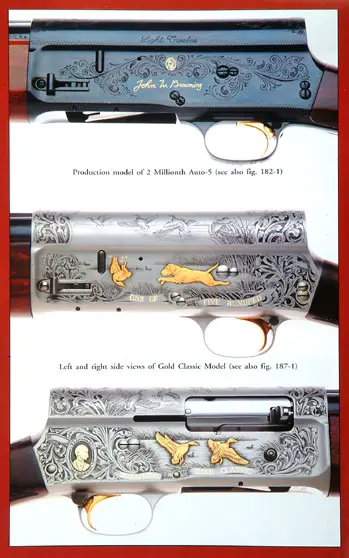


Confessions of a Browning A-5 Aficionado

There are twice as many pheasants than Wakemans in this picture and A-5s dropped them all.
The Browning A-5, the most important shotgun ever made, is likely also one of the most misunderstood shotguns today despite its 110 year history. Still, to this day, there is an amazing amount of misinformation and misunderstanding about what it was, what it is, and what it does. Though perhaps perceived at its very best in the field, the A-5 won its fair share of National Skeet Championships in the form of the Remington Model 11. Whether an A-5, the licensed Savage 720 or Remington Model 11, or the versions after the Browning patents ran out (Remington 11-48, Franchi AL48), the A-5 is easily the most influential shotgun ever made.
It was never designed to be quickly completely disassembled. The ultra-thin screws of the Belgian A-5 served as a deterrent to the would-be home hobbyist gunsmith. Likely more A-5's have been damaged by amateur smithing attempts than any other gun. The information is readily available on what to do, though. Anyone can download the field service manual from Midwest Gun Works if they are just curious. I'm often asked by people who have inherited or otherwise obtained fifty year old A-5's “what they should do.” Well, most every mechanical device that you care about deserves a professional service every fifty or sixty years or so, whether you think it really needs it or not.
Art's Gun and Sports Shop of Hillsboro, Missouri is the best in the business. You can tune into Art's at http://www.artsgunshop.com and watch videos of Art Isaacson himself working on bringing an old A-5 twenty gauge back to life. While periodic field-stripping, inspection, lubrication, and normal cleaning is easy enough as described in the A-5 owners manual, beyond replacement of brass friction rings and a perhaps a recoil spring, the innards of an A-5 are best left off to a professional like Art who has done thousands of them. It costs more to have to have a pro like Art first undo a bad “fix” and then “re-fix” it the right way rather than just asking him to just do it right the first time.
The notion that an A-5 “kicks” is completely wrong. Properly set-up, they are some of the softest-shooting shotguns ever made-- but, only of you do your homework. Rumor has it that John Browning suggested 30W motor oil to lightly lubricate the magazine tube. The first of the A-5 patents (Patent No. 659507) was awarded on October 9, 1900. While that may well be, it all has to be put into context. The Ford Model T was introduced eight years later, in 1908. We have far better-performing lubricants, protectants, and motor oils today.
My great-grandfather, George Chamberlain Wakeman, who I had the good fortune to know quite well, was a farmer and commercial hunter. Aside from punt-guns, his two favorite shotguns were a damascus-barreled Ithaca Side by Side and a Remington Model 11. Great Grandpa was hard, very hard on his guns. They were just tools and he shot them to pieces and could rarely be accused of cleaning them. He shot the vent rib off of his Model 11 and just kept on shooting. When he was done hunting, the Model 11 always ended up in the same place, in the kitchen, leaning on the wall behind the refrigerator. That Model 11 is fully functional today. My grandfather's sole hunting gun for most all of his life was a Belgian A-5. My Dad saved his paper-route money and after a couple of years bought a used Winchester 1897 12 gauge as his first shotgun. That did the trick for a long while, but a very bad electrocution required skin grafts and made his left hand worthless for shucking for a while. Not letting accidental contact with an 11kV line ruin pheasant hunting, Dad went the A-5 route, finding that he could balance the A-5 on the wrist of his claw-like left hand and still make it rain pheasants without needing to shuck. Dad's hand got better, but the A-5 was there to stay dropping pheasants permanently. Many guns aspire to be lifetime guns but the A-5 is the genuine article. A-5's have already made the trek through five generations of Wakeman hunting, anyway, so I can personally attest that they are more than just lifetime gun wannabees. A-5s are the real deal.
There are several things about the A-5 often misunderstood in addition to the wrongful notion of recoil. To finish up on the recoil notion, while down in Argentina a few years back one of the bird boys asked if I liked A-5s. Of course, the answer was yes. He proudly brought out his A-5; to say it looked rode hard and put away wet would be an understatement. He asked if I wanted to try it and I said, “Of course.” Now, that A-5 kicked. It practically tore my shoulder off. I popped off the barrel and there was no bronze friction piece, no bevel ring, no nothing. Just a barrel on a spring. I asked if he understood that some critical parts were missing and he said, “The little pieces? Don't need them-- threw them away ten years ago.” I mentioned that he'd likely have a lot more comfortable gun with those little pieces installed properly. He said, “No. This is the best. This is the best gun ever. It never jam. It never jam.” I didn't doubt him. That A-5 cycled just fine, even though the back of the receiver was pounded mercilessly with every shot and apparently had been enduring that for years.
I've purchased countless A-5s over the years, new and used. To date, I have never had a used A-5 received with the bronze friction piece and the bevel ring set up correctly, not one. Sure, I hear that A-5s kick. The first question is about the friction piece and ring set-up. The normal reply is, “What is a friction piece?” So, there you go.

The Dromedary rarely gets the respect it should in the animal kingdom. It properly displays a hump, not the A-5.
You'll also hear a lot about “the hump.” Actually, A-5s have no hump. Those with a sincere interest in humps will refer to the Bactrian camel and the Dromedary. The Dromedary is of course the one hump camel, while the Bactrian has two. Those are legitimate humps, far predating the A-5. The A-5 bears no semblance to either. The hump is just an inaccurate way to refer to a squared-off receiver, which isn't all that confusing to begin with. Most repeating shotgun receivers are squared off at the front and on the top, so the idea of another squared-off side should baffle no one. The only thing actually approaching a hump on most shotguns is the trigger guard.
The squared-off receiver of the A-5 serves a purpose, though. It provides an instant, broad sighting plane that also removes any need for a barrel rib, ventilated or otherwise. All you see is top of the bead whether your A-5 has a barrel rib or not.
The A-5 design promotes keeping your head-up, with no stock-crawling. You won't hear of people getting their faces slapped with the comb of an A-5 as it typically the side of your jaw you are shooting off of, not plunging your cheek into the wood. Too much comb can be a real face-breaker, I can tell you that from experience. Not the case with the A-5 at all. It is instinctively fast to shoulder and fire with very little movement of your head. For those who say they “don't like looking at the hump,” well-- if you are looking at the hump you likely just don't know how to shoot an A-5.
Certainly A-5 shotguns do not fit all individuals perfectly. This really shouldn't be cause for great duress, as S x S or O/U shotguns also do not fit everyone perfectly, either. Adding length of pull to an A-5 is just as easy as a pad or pad and spacers as any other shotgun. We don't think much of adjustable combs and other stockwork when needed for other shotguns, so it should hardly be considered worthy of great trauma if the shotgun happens to be an A-5.
The other idea out there is that “A-5s are always heavy.” That too is just isn't always the case. The recently tested A-5 20 Mag weighs 6.5 lbs. We can call it light, we can call it heavy, but 6.5 pounds (unless gravity is different in your neck of the woods) is just 6.5 pounds. Though rare, the A-5 was made in an alloy-receiver “SuperLight” version, rarely seen. Browning though, likely correctly, that American hunters were a bit rough with their guns and that the weaker alloy receiver was not a good choice for the American market. When you have a steel barrel and steel breechblock repeatedly recoiling back into an alloy receiver, sooner or later steel wins. Also, weight between the hands adds smoothness to the swing, offers better handling, and is something that alloy takes away from the A-5. Steel also holds sharp crisp engraving where alloy attempts usually look cheap and muddy by comparison.
The older licensed versions of the A-5, the Remington Model 11 and the Savage 720, both have good track records as well. They do lack the refinements of the later A-5s, like the magazine cut-off and speed loading, but were nevertheless built upon the same impressive action. If imitation is the more sincere form of flattery, the Franchi AL48 flatters the A-5. Waiting until the Browning patents had expired, Franchi was free to attempt to copy the A-5 without paying licensing fees-- and that, they did.
The Franchi AL48 has an alloy receiver making it cheaper to build and lighter in weight. It has its own following, but lacks the refinements of the later A-5's as well and is by no means as durable. Yet, strong enough is strong enough. The AL48s I've personally owned have been lacking in wood quality as well, with heavy and mushy triggers compared to the A-5. It is still being produced today in a couple of models, but never had the magic of the A-5. Perhaps it is because Franchi never went far enough, ignoring at least what I feel are the two best upland versions of the A-5, the Sweet Sixteen and the Mag 20.
When the A-5 production shifted from FN to Miroku in Japan, both good and bad things happened. The Miroku guns are well-made, perhaps better made than the FN product in the sense of harder steel. Along with Miroku came an end to some of the hand work, the hand checkering and better engraving that was now done more economically, if less artfully in Japan. A-5s also got heavier, with heavier screw-choked barrels and thicker forearms. The vent ribs, not functional in field use, were added to Miroku guns as standard fare making their weight non-optional. The Miroku guns also became heavier for another reason; their barrels were longer. The Belgian Brownings had metric length barrels, so a “28 inch” Belgian Browning actually had about a 27.5 inch barrel. The Belgian “blue” (that actually had some blue hue to it) was gone in the Miroku guns, now just hot salt black like most guns today. Perhaps better, perhaps cheaper to apply, but yet another subtle loss of the Belgian mystique.
The A-5 20 Mag I reviewed weighs exactly 6 lbs. 7 oz. I also have an A-5 20 Mag Miroku, with just amazing wood. However, my “26 inch” Miroku 20 Mag with Invector screw chokes weighs 7 lbs., 7 oz., one full pound more than the Belgian A-5 20 Mag. Sure, it is just as well made, perhaps stronger, certainly more versatile with its factory screw-chokes and rated for steel barrel. But, a full pound on a 20 gauge is a pretty hefty price to pay for this “wondrous versatility.”

The 2,000,000th Commemorative A-5 on top, followed by two shots of the A-5 Gold Classic. (Image courtesy of Wet Dog Publications, publisher of Browning Auto-5 Shotguns, The Belgian FN Production.)
So it went with the rest of the A-5 line, to the point where the last production of the A-5 “Light Twelves” were heavier than vintage FN 12 gauge “Standardweights,” much less the Belgian “Light Twelves.” Still costly to produce compared to some of the now blow-molded punch press competition, the notion that the A-5 was heavy and ponderous compared to some autos, while never true during FN production, was becoming more true every year in Japan. Still the greatest of all time, like the old prize-fighter that stuck around for a few too many fights than he really should have, the now pudgy A-5 lost its edge.
For those that know what they are looking for, the A-5 cannot be bettered. For the reasons described, the FN production from the late 1950's through 1975 or so remains the very best of a very fine breed.
Copyright 2010 by Randy Wakeman. All Rights Reserved.




